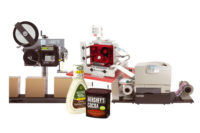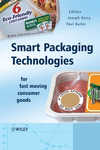Labels continue to play a major role in business-to-consumer and business-to-business commerce, building brands, shipping, keeping track of inventory and, today, even talking to consumers. With more labeling choices available than ever before, here is a brief guide to help you choose the right product for the right application.
Pressure-sensitive remains the fastest growing labeling technology today. It offers near-perfect labeling accuracy and material and adhesive options for virtually all application environments, including temperature, humidity and surface variations. Adhesives and substrates are suitable for a wide range of surfaces, including paper, plastic, glass, wood, textiles and metal.
A wide range of substrates — films, paper, metallic foils and paper, magnetic and even fabric — accommodate a variety of package designs to elevate brand image while improving manufacturing efficiencies and driving down total costs.
This is a good choice for both rigid and flexible/squeezable containers; pressure-sensitive labels can flex with the package while maintaining integrity. In fact, pressure-sensitive tube label use has grown due to lead times required for preprinted tubes and limitations on color and design.
Many home and personal care packaging designers desire a “no-label” look that allows the product color to be visible; pressure-sensitive is a great choice for this application. It’s also a good choice for die-cut applications.
Printing methods may include flexo (UV and water-based), digital, screen, letterpress and gravure to achieve the right balance between image clarity, quality and cost.
Shrink sleeve labeling remains a fast-growing option in the flexible packaging segment, providing the opportunity to create top-to-bottom, 360° decoration on containers that translates directly to shelf appeal. This application is a good choice for virtually any vessel shape — unique, curvy designs as well as standard containers. High shrink films with a shrink rate of up to 79 percent are a good choice for containers with reduced contours on the top and bottom. Medium shrink films are the choice for highly contoured bottles.
Craft beverage has become a strong shrink sleeve market as smaller runs allow affordable labeling on cans; seasonal products can virtually be produced on demand with no waste of leftover labels. Customization surrounding special events or marketing to specific names or groups are also ideal applications.
Shrink sleeve options also mean that pre-existing containers that contain outdated product information can be used instead of being sent to the landfill. That not only reduces cost but eliminates the need to send a perfectly good product into the waste stream ahead of its time.
Cut-and-stack options remain a popular standard for labeling large quantities of metal cans and glass bottles and jars. They are the lowest priced option for product decoration, offering fast, efficient application for producers of food and beverage, household and industrial products. Once printed on large sheets or rolls, the labels may be die cut into specific shapes or, more generally, cut into square or rectangular shapes, and stacked for application.
BOPP film technology has been added to what was once a primarily paper-based market due to its ability to resist moisture, tears and scratches as well as excellent label clarity. The high quality print finish enhances the look of any product to make it stand out on the shelf.
Direct thermal linerless labels are an excellent option for postal and shipping, warehousing and transportation, weigh scale and mobile print labeling. By eliminating the liner on direct thermal blanks, users get up to 60 percent more labels per roll, adding efficiency due to the need for fewer roll changes while speeding operations and improving warehouse utilization. Die cutting is not required, which eliminates matrix and liner waste. That means no liner disposal costs. It also adds a degree of safety, as workers don’t face a falling risk from liners laying on the floor.
Intelligent labels can include near field communication (NFC) or radio frequency identification (RFID) to perform a wide variety of tasks. Marrying these capabilities with traditional labels is perhaps the most dramatic development in labeling over the past decade. Brands can now literally talk to consumers in-store or after purchase via smartphone apps. Brand stories, recipes, product manuals, games — virtually any interaction that a brand can dream up — can become a brand-to-consumer experience that was unheard of up until now.
Similarly, brands in industries such as pharmaceuticals, wine and spirits, and apparel can use this technology for in-house inventory management or prevent counterfeiting. Retail shrinkage has seen a significant reduction, particularly in the apparel industry, with the application of intelligent labels. The technology has revolutionized warehousing, shipping and inventory operations. And intelligent labeling technology has come to the aid of the airline industry to help prevent one of the greatest air travel annoyances — lost baggage. Airlines applying intelligent labels as part of their bag tagging system have seen dramatic reductions of lost luggage, saving time, cost and customer aggravation.
Sustainability plays a major role across the labeling spectrum and should be built into any labeling specification. Consumers demand it and have come to expect it. Using labeling materials such as responsibly sourced paper (look for Forest Stewardship Council, or FSC, certification), improve recyclability of the container and/or label, use recycled materials or simply reduce material usage — which results in fuel and shipping savings — are great ways for a brand or a business to enhance its own sustainability story.
Consumers are willing to pay more for a product that is sustainably packaged, and many seek such products out as they make their purchasing choices. Today’s label manufacturers and sustainably-conscious converters have a wealth of know-how to help a brand or company enable a sustainable labeling program of all levels of the business — from product packaging to everyday operations and logistics.




